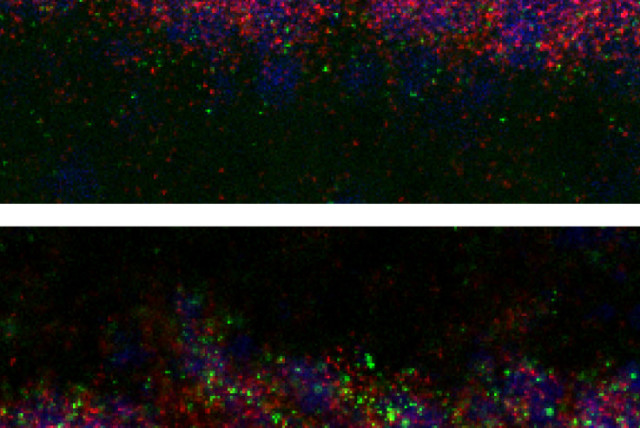Traces of emotional trauma from war? Here's how you can erase them - study

Israelis are agonized over the thought that they will suffer from long-time emotional trauma due to what they endured.
Israelis – even those who don’t know personally any children who have returned from Hamas captivity – are agonized over the thought that they will suffer from long-time emotional trauma due to what they endured.
The images of Israeli child hostages being freed from Gaza are a relief, but for most of these children, the release is just the start of a long rehabilitation process. Countless studies have shown that exposure to warfare, abuse, and other traumatic events at a young age significantly raises the risk of ill health, social problems, and mental health issues later in life.
Now, a new mouse study by researchers at the Weizmann Institute of Science in Rehovot provides a reason for optimism. In research conducted on mice and just published in the journal Science Advances. under the title “Early life adversity shapes social subordination and cell type–specific transcriptomic patterning in the ventral hippocampus,” a team headed by Prof. Alon Chen discovered brain mechanisms that go awry as a result of exposure to trauma in infancy and showed that these changes may be reversable if treated early.
Brains have the ability to adapt, change throughout our lives
Our brains have a wonderful quality known as plasticity – the ability to adapt and change throughout our lives. As may be expected, in our early years, when the brain is still developing, it is at its peak to plasticity. This shows up in, for example, the aptitude for learning languages, but this also entails a heightened sensitivity to traumatic events that are liable to leave a scar that only intensifies with age.
Many studies provide evidence for this harmful effect, but very little is known about the way that exposure to trauma at a young age affects the different kinds of brain cells and the communication between them in adulthood.
Chen’s brain sciences department lab focuses on the molecular and behavioral aspects of the response to stress. In previous studies, Chen’s team examined how stress during pregnancy affects mouse offspring when they reach maturity. In the current research, the scientists – led by Dr. Aron Kos – studied how trauma experienced shortly after birth affects mouse pups later in life.
To advance the understanding of this topic, the researchers integrated the lab’s various strengths including its expertise in exploring the brain’s molecular processes at the highest possible resolution, using genetic sequencing on the level of individual cells; the ability to use cameras to track dozens of behavioral variables in a rich social environment intended to recreate natural living conditions; and the ability to process the massive quantities of data generated in this environment, using machine learning and artificial intelligence tools.
This comprehensive behavioral mapping showed that mice exposed after birth to a traumatic event – in the case of this study, being neglected by their mothers – displayed a variety of behaviors indicating that they found themselves at the bottom of the dominance hierarchy.
“Equivalent behaviors in humans might include high levels of introversion, social anxiety and having an avoidant personality, all known to be characteristic of post-trauma,” said Dr. Juan Pablo Lopez, a former postdoctoral fellow in Chen’s joint lab at Weizmann and the Max Planck Institute of Psychiatry in Munich who is today head of a research group in the neuroscience department at the Karolinska Institute in Stockholm.
In the next stage of the study, the researchers exposed some of the adult mice that had experienced trauma in infancy to a stressful social situation – bullying by other mice. Finally, they created four groups of adult mice – those that had not been exposed to any trauma; those that had not been exposed to trauma in infancy but were subjected to bullying as adults; mice that were exposed to trauma only in infancy; and mice that were exposed to both trauma in infancy and bullying as adults.
To find out how exposure to early trauma disrupts the brain and what happens as a result of this in adulthood, the researchers carried out a careful comparison of the four groups using RNA sequencing at the single-cell level in the hippocampus, which is a brain area that plays an important role in social functioning. The comparison revealed that early trauma left a mark on different types of cells, primarily affecting gene expression in two subpopulations of neurons, those belonging to the glutamatergic excitatory system and those belonging to the GABA inhibitory system. This effect was especially strong in mice that had been exposed to both trauma in infancy and bullying as adults.
Cells in the brain communicate with one another by means of electrical signals, which can be excitatory (stimulating) or inhibitory. An excitatory signal encourages communication between brain cells, while an inhibitory signal represses it like the gas and brake pedals in a car. Normal brain functioning requires a balance between the excitatory and inhibitory signals, which is lacking in many psychiatric disorders.
One of the ways of assessing the brain’s electrical activity and the balance between excitatory and inhibitory signals is through electrophysiological measurements. Such measurements, performed in the hippocampus of the mice by Dr. Julien Dine, a former staff scientist at Weizmann and now a pharmaceutical electrophysiologist, supported the molecular findings – that exposure to trauma in early childhood disrupted the balance between excitatory and inhibitory signals in adulthood.
Having discovered a brain mechanism that is disrupted in adulthood as a result of early trauma – and having identified this disruption as an imbalance between the excitatory and inhibitory signals – the researchers tried to find a way to fix it. During a brief treatment window shortly after the early trauma, they gave the mice a well-known antianxiety drug – diazepam, known commercially as Valium – which affects the GABA inhibitory system.
This short course of treatment led to results that were nothing less than stunning: The treated mice were able to fully or almost fully avoid the behavioral future that awaited them and were no longer at the foot of the social ladder.
“Understanding the molecular and functional mechanisms allowed us to neutralize the negative behavioral impact of trauma with a drug given shortly after exposure to traumatic incidents,” Kos explained. “This certainly should not be seen as a recommendation to treat young trauma patients with drugs, but our findings do highlight the importance of early treatment for successful rehabilitation.”
Intense, ongoing stress can, at any age, contribute to disease, from psychiatric disorders to obesity and diabetes. But in the first years of life – and also in the womb – such stress can have dramatic ramifications.
“The wars in Israel, Ukraine, Sudan and elsewhere, and the unprecedented global refugee crisis that is caused, in part, by climate change, alongside an increased understanding of the long-term harm caused by exposure to war and violence at a young age – all these highlight the need for better rehabilitation capabilities,” Chen concluded. “Our study identifies a key brain mechanism that is especially sensitive to childhood trauma. But the most exciting part is the prospect of using the plasticity of the young brain to help it recover, avoiding the toll this trauma can exact in adulthood.”
Jerusalem Post Store
`; document.getElementById("linkPremium").innerHTML = cont; var divWithLink = document.getElementById("premium-link"); if (divWithLink !== null && divWithLink !== 'undefined') { divWithLink.style.border = "solid 1px #cb0f3e"; divWithLink.style.textAlign = "center"; divWithLink.style.marginBottom = "15px"; divWithLink.style.marginTop = "15px"; divWithLink.style.width = "100%"; divWithLink.style.backgroundColor = "#122952"; divWithLink.style.color = "#ffffff"; divWithLink.style.lineHeight = "1.5"; } } (function (v, i) { });

